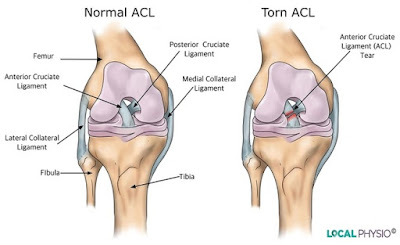The anterior cruciate ligament (ACL) is considered one of the major ligaments in the knee.
When the ACL is torn, the condition is aptly referred to as ACL injury.
Most ACL injuries occur during sports that entail jumping, drastic direction changes, and sudden stops like soccer, football, volleyball, gymnastics, tennis, basketball, and downhill skiing.
Many people often feel or hear a “pop” in the knee during an ACL injury.
The knee may also swell and feel unstable.
In addition, bearing weight might become too painful.
Treatment options recommended will depend on the injury’s severity.
Depending on the situation, an ACL injury may require rehabilitation exercises and rest (to regain stability and strength) or it may require surgery (to replace the ligament that is torn).
Causes
The strong tissue bands that connects one bone to another are called ligaments.
The ACL is one of the two ligaments in the knee.
It connects the femur (thigh bone) to the tibia (shin bone).
It also helps stabilize the knee joint.
Majority of ACL injuries occur during fitness and sports activities, and can happen when:
· Drastically changing directions or slowing down suddenly
· Pivoting with the foot firmly planted
· Suddenly stopping
· Incorrectly landing from a jump
· During collision or when receiving a direct knee blow
Damage to the ligament can be partial or complete.
A mild injury can overextend the ligament but still leave it intact.
Symptoms
Some of the most prevalent signs of an ACL injury includes:
· A “popping” sensation or a loud “pop” in the knee
· Inability to continue activity
· Extreme pain
· Swelling (often manifests within a few hours)
· Range of motion loss
· Feeling of instability
Diagnosis
During the physical examination, the doctor will move the knee into several positions to gauge the range of motion and the joint’s overall function.
Signs of tenderness and swelling will also be checked.
In most cases, diagnosis can be made based on the physical exam alone.
However, other tests might be recommended to determine the injury’s severity and rule out other likely causes.
Tests can include:
· Magnetic resonance imaging (MRI)
· X-rays
· Ultrasound
Treatment
Home Care
Prompt first aid care has been known to help reduce the swelling and minimize the pain after a knee injury.
The R.I.C.E. model is often recommended.
Rest – limiting weight bearing and resting is considered ideal.
Ice – putting ice on the knee preferably every 2 hours (for 20 minutes each time) is recommended.
Compression – wrapping a compression wrap or an elastic bandage around the injured knee is advised.
Elevation – lying down with the affected knee propped up on some pillow is suggested.
Rehabilitation
Treatment for ACL injuries often commence with many weeks of rehabilitative therapy.
Exercises at home or with continued supervision will be taught by a physical therapist.
Wearing a brace (to stabilize the knee) or using crutches (to avoid weight bearing) might also be prescribed.
The key goals of rehabilitation include restoration of the knee’s full range, minimizing swelling and pain, and strengthening the muscles.
Surgery
Surgery might be recommended in the following scenarios:
· Patient is an athlete and wants to continue doing sports that entail cutting, pivoting, and jumping
· More than one cartilage or ligament in the knee is injured
· Patient is active and young
· The injury causes the knee to buckle up when doing routine day-to-day activities
During ACL reconstruction, the damaged ligament is removed and it replaced with a segment of tendon.
The replacement tissue is called a graft.
The surgeon will then use another piece of tendon (taken from another part of the knee or from a deceased donor).
The graft will function as a scaffolding where new ligament tissues can grow.
Another course of rehabilitative therapy is undertaken after surgery.
Rigorous rehabilitation and successful ACL reconstruction can often restore knee function and stability.
Oftentimes, athletes can already continue to engage in sports after just 8 to 12 months.






